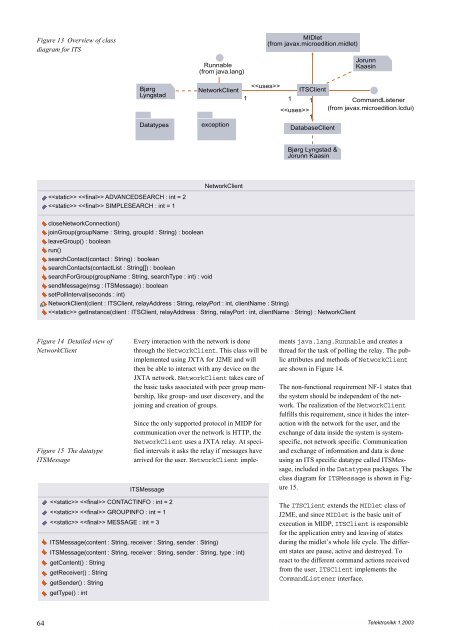Intelligent Transport Systems - Telenor
Intelligent Transport Systems - Telenor
Intelligent Transport Systems - Telenor
You also want an ePaper? Increase the reach of your titles
YUMPU automatically turns print PDFs into web optimized ePapers that Google loves.
Figure 13 Overview of class<br />
diagram for ITS<br />
Figure 14 Detailed view of<br />
NetworkClient<br />
Figure 15 The datatype<br />
ITSMessage<br />
64<br />
Bjørg<br />
Lyngstad<br />
Datatypes<br />
ADVANCEDSEARCH : int = 2<br />
SIMPLESEARCH : int = 1<br />
Runnable<br />
(from java.lang)<br />
NetworkClient<br />
exception<br />
NetworkClient<br />
Every interaction with the network is done<br />
through the NetworkClient. This class will be<br />
implemented using JXTA for J2ME and will<br />
then be able to interact with any device on the<br />
JXTA network. NetworkClient takes care of<br />
the basic tasks associated with peer group membership,<br />
like group- and user discovery, and the<br />
joining and creation of groups.<br />
Since the only supported protocol in MIDP for<br />
communication over the network is HTTP, the<br />
NetworkClient uses a JXTA relay. At specified<br />
intervals it asks the relay if messages have<br />
arrived for the user. NetworkClient imple-<br />
1<br />
<br />
MIDlet<br />
(from javax.microedition.midlet)<br />
ITSClient<br />
1 1<br />
<br />
1<br />
DatabaseClient<br />
Bjørg Lyngstad &<br />
Jorunn Kaasin<br />
closeNetworkConnection()<br />
joinGroup(groupName : String, groupId : String) : boolean<br />
leaveGroup() : boolean<br />
run()<br />
searchContact(contact : String) : boolean<br />
searchContacts(contactList : String[]) : boolean<br />
searchForGroup(groupName : String, searchType : int) : void<br />
sendMessage(msg : ITSMessage) : boolean<br />
setPollInterval(seconds : int)<br />
NetworkClient(client : ITSClient, relayAddress : String, relayPort : int, clientName : String)<br />
getInstance(client : ITSClient, relayAddress : String, relayPort : int, clientName : String) : NetworkClient<br />
ITSMessage<br />
CONTACTINFO : int = 2<br />
GROUPINFO : int = 1<br />
MESSAGE : int = 3<br />
ITSMessage(content : String, receiver : String, sender : String)<br />
ITSMessage(content : String, receiver : String, sender : String, type : int)<br />
getContent() : String<br />
getReceiver() : String<br />
getSender() : String<br />
getType() : int<br />
Jorunn<br />
Kaasin<br />
CommandListener<br />
(from javax.microedition.lcdui)<br />
ments java.lang.Runnable and creates a<br />
thread for the task of polling the relay. The public<br />
attributes and methods of NetworkClient<br />
are shown in Figure 14.<br />
The non-functional requirement NF-1 states that<br />
the system should be independent of the network.<br />
The realization of the NetworkClient<br />
fulfills this requirement, since it hides the interaction<br />
with the network for the user, and the<br />
exchange of data inside the system is systemspecific,<br />
not network specific. Communication<br />
and exchange of information and data is done<br />
using an ITS specific datatype called ITSMessage,<br />
included in the Datatypes packages. The<br />
class diagram for ITSMessage is shown in Figure<br />
15.<br />
The ITSClient extends the MIDlet class of<br />
J2ME, and since MIDlet is the basic unit of<br />
execution in MIDP, ITSClient is responsible<br />
for the application entry and leaving of states<br />
during the midlet’s whole life cycle. The different<br />
states are pause, active and destroyed. To<br />
react to the different command actions received<br />
from the user, ITSClient implements the<br />
CommandListener interface.<br />
Telektronikk 1.2003
















